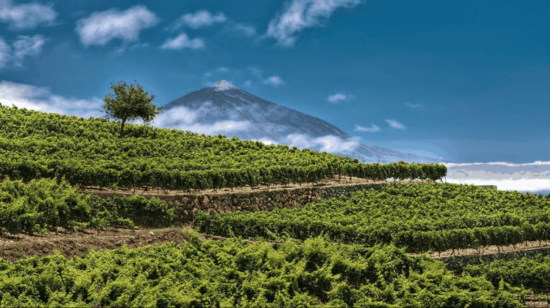
Wine can be high-priced, high-falutin’, even high-minded. But the kind of loftiness that matters most – at least as far as the cultivation of the wine vine is concerned – has a more earthbound, geo-location kind of vibe, involving two commonplace, readily-comprehended concepts: altitude and latitude.
That the two make an anagrammatic pair and sound so much alike (not true of most anagrams) may account for both the utility and appeal of the old wine trade adage that altitude mimics latitude. Which is just shorthand for a phenomenon well understood even in the ancient world: namely, that effects on fruit grown at higher elevations above sea level* mirror those occurring at farther removes from the equator. It’s a reciprocal relation. We could just as well say that latitude mimics altitude and the sense would be just the same.
So how does it work? Begin with the fact that some places are too warm and others too cold for the wine grape to thrive. To ripen fruit suitable for winemaking requires average minimum temperatures of about 54 degrees Fahrenheit from April through October in the northern hemisphere. Imagine, then, a band of territory defined by latitude, at sea level, circling the globe that meets this requirement and you’ll have set the boundaries of the Kingdom of Wine, right?
Not quite, since all of the land included in this band will not be at sea level but sometimes well above it, and that average temperatures fall as elevation rises. This means that some areas at or even below wine’s too-warm boundary can be fully viable if the vineyards there are sited at sufficient altitude.
An extreme example of this can be seen on Spain’s Canary Islands (in photo, above) located a scant 5 degrees from the Tropic of Cancer — a latitude it shares with Saudi Arabia, Myanmar and Florida, by the way — and which boasts some lofty vineyard plots indeed, some above 5,000 feet.** The principle seems to be that the hotter it is at sea level, the higher up you can, and in some cases must, go.
The reverse also holds true. Vineyards in Germany’s Rheingau region at 50 degrees north latitude seldom rise above about three hundred meters (1000′) where, in that climate, vine viability peters out. A host of other local factors play roles in all this, of course, but don’t obviate the basic rule.
What’s of particular interest here is that, in general, the higher you go in terms of either altitude or latitude, the finer the wine is thought to be, in theory at least and to a point. Notable exceptions exist, as will always be the case. But it’s worth noting that French appellation rules encode the rule by routinely endowing fruit grown on its côtes (slopes) a distinct and higher – there’s that word again – place in its hierarchy than wine sourced in the same region’s flatlands.
High end wine? It’s not just about the price.
-Stephen Meuse
*Technically, altitude refers to height above the earth and is properly used only in relation to balloons, aircraft and satellites, while elevation refers to height above sea-level. You’ll hear the terms used interchangeably.
**About the height of Mt. Lincoln in New Hampshire’s Presidential Range.